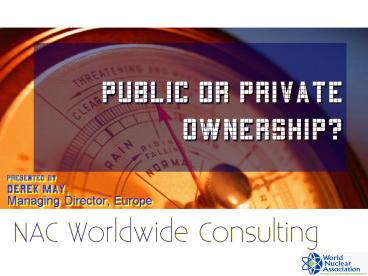Public or Private Ownership - PowerPoint PPT Presentation
1 / 21
Title:
Public or Private Ownership
Description:
Relieve themselves of financing requirements/raise money ... Fuel Fabrication. 1990. 1995. 2001. 10. Public or. Private. Ownership? NAC. Worldwide. Consulting ... – PowerPoint PPT presentation
Number of Views:96
Avg rating:3.0/5.0
Title: Public or Private Ownership
1
Public or Private Ownership?
- Presented by
- Derek May,
- Managing Director, Europe
NAC Worldwide Consulting
2
Contents
- Background
- Public/Private Ownership
- Generation
- Fuel cycle
- Performance Differences
- Natural Barriers to Private Ownership
- National Differences
- Future Developments
3
Definition of Privatisation
- A significant proportion of the company equity
and/or voting rights are owned by private entities
4
Rationale for Privatisation
- Typically governments wish to
- Relieve themselves of financing
requirements/raise money for government
expenditure in other areas - Step back from interfering in the operation of a
(newly) liberalised market - Distance themselves from potentially difficult
decisions - Better separate regulation and management
- Enable greater efficiency of operation and
business development to be undertaken by more
commercially motivated (and international)
management - Transfer risk to the private sector
5
Worldwide Nuclear Generation
2,009 TWh
2,228 TWh
2,544 TWh
1990
1995
2001
6
Uranium Mining
1990
1995
2001
7
Hex Conversion
1990
1995
2001
8
Enrichment
1990
1995
2001
9
Fuel Fabrication
1990
1995
2001
10
Reprocessing
1990
1995
2001
11
PWR Load Factors in 2001(1)
Source Nuclear Engineering International
12
PWR Load Factors in 2001(2)Excluding France
13
PWR Load Factors in 2001(3)
14
PWR Load Factors in 2001(4)Load Factors Above 90
15
PWR Load Factors in 2001(5)Load Factors Below 75
16
Reactor Operations CostsAverage U.S. Reactor
Production Costs versus Average Nuclear
Production Costs for TVA
17
Industrial Safety Accident Rate
Source WANO 2001 Performance Indicators
18
Natural Barriers to Private Ownership
- Generation
- Operation can be public or private
- New construction not yet funded privately in a
liberalised electricity market - Public ownership/private operation (Bruce Power)
- Fuel cycle
- Mixed ownership in most segments
- Biggest two players are government owned
- BNFL slated to move into private sector in next
few years - No current private involvement in reprocessing,
BUT - Private Japanese plant under construction
- Private BNFL may operate publicly owned
Sellafield in future - Waste Disposal
- Private operation of disposal sites is common
- Public ownership of spent fuel/long-lived
reprocessing waste is the norm
19
Natural Differences
- Four main clusters
- Mainly privately owned, liberalised market
- United States, Germany, Spain
- Mainly privately owned, regulated market
- Japan, Switzerland
- Mixed ownership, liberalised market
- United Kingdom, Scandinavia, Holland, Belgium
- Public ownership, regulated market
- France, Russia, Korea, Eastern Europe, China,
Taiwan
20
Future Developments
- Continuing trend to private ownership/involvement
- Continuing significant role of private
contractors - Accompanying trend to market liberalisation
- Eventual development of spent fuel
disposal/reprocessing waste disposal sites likely
to see public ownership private operator
approach
21
Relative Performance of Nuclear Equity Investments
22
Future Developments
- Continuing trend to private ownership/involvement
- Continuing significant role of private
contractors - Accompanying trend to market liberalisation
- Eventual development of spent fuel
disposal/reprocessing waste disposal sites likely
to see public ownership private operator
approach































